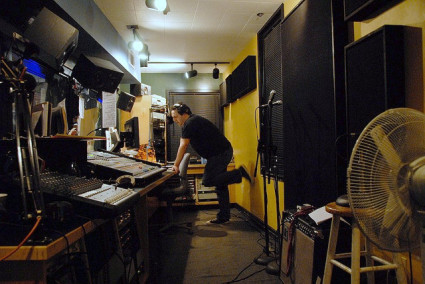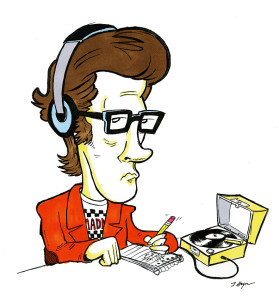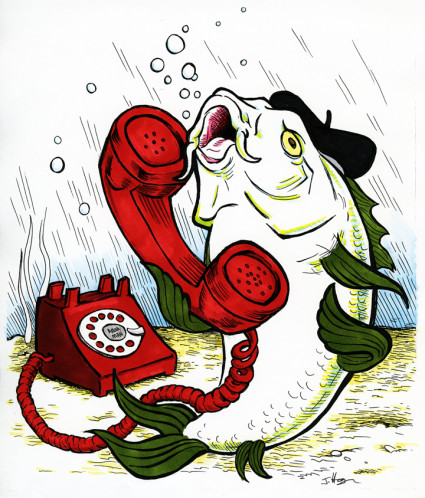In the 21st Century, it seems that everyone’s a prospect, has something to sell, or both. To stay balanced, we need people who can mess with our minds in ways that leave us more savvy, more curious, and more creative. If such people make us laugh, that’s a bonus. This is a tribute to two of these from Emerson Dameron a writer, storyteller, and humorist searching for signs of mischief in a world plastered with ads.
All illustrations are by the inimitable Los Angeles artist John Hogan.
“I like anyone with a dream.”
– Tom Scharpling
Great radio theater envelops its listeners in a vivid alternative reality and compels them to examine their own worlds more closely when they return. The best great radio theater twists their assumptions about themselves and makes them laugh for reasons that may be hard to explain to the world outside their headphones.
Until late 2013, Scharpling and Wurster, one of the underground’s favorite long-form radio comedy duos, made a home for themselves on WFMU, an influential and beloved freeform radio station broadcasting from New Jersey. They made sport of poseurs, snobs, and sleazebags in an elaborate world of their own creation. They are missed.

Tom Scharpling published the zine 18 Wheeler, wrote for the TV show Monk, and clerked in a music store. Jon Wurster is the original drummer for the North Carolina indie-rock band Superchunk and has played with Robert Pollard, the Polyphonic Spree, and many others. For over a decade, they collaborated on a unique and uncanny brand of phone-prank magic.
The duo’s shenanigans officially began in 1997, when Scharpling was still a music-focused DJ. One night, he fielded a call from a snotty rock critic named Ronald Thomas Clontle. RTC checked in to promote his new book Rock, Rot & Rule, which he proposed as the ultimate rock-snob argument-settler.
Clontle’s credentials were hard to dispute. He saw the Beatles and Stones live in their heydays and wasn’t impressed, claiming they both already sounded “bloated” to his well-trained ears. To drive his point home, he shared some of his rankings and opinions, which ranged from debatable to outright stupid. (He reserved special praise for Madness, the inventors of ska.)
‘FMU’s listenership skews toward music-savvy cranks, and outraged callers fried the phone lines to take the piss out of Clontle. Almost no one was in on the joke – Clontle, was, in fact, Wurster, Scharpling’s writing partner, and the two were collaborating on a prank intricately crafted to have their particular audience crying for blood.

That call-and-response became notorious among tape-traders. In 2000, Scharpling launched The Best Show on WFMU, largely dedicated to more of these long, twisting, mind-bending riffs between himself and a growing and interconnected cast of characters from the sinister and fictional Jersey suburb of Newbridge.
There was the Gorch – imagine the Fonz fallen on pitch-black days – who liked to assault people with a chain for minor infractions. Kid eBay was a self-appointed pop-culture authority not unlike Clontle but somehow even more infuriating. Philly Boy Roy often touched base to boost the city so many Jersey natives love to despise. Corey Harris of the dude-rock band Mother 13, the entitled older brother of Pat Sajak, and the editor from Pizza Aficionado magazine all joined the fun, all portrayed in uproarious and sometimes genuinely frightening detail by Wurster.
Here, Tom tangles with the aforementioned journalist, a man who may take pizza a little too seriously:
As the sketches got more absurd, certain patterns became more engrained. Almost all of Wurster’s characters had far-fetched, sleazy schemes going. They shared a distinctive slang vocabulary (“the hut” was prison, of which many spoke from experience). Many were menacing bigots, and many finally alienated the host for good when they threatened his life.
Scharpling played the puffed-up, moralistic straight man, increasingly disgusted with his foils but inquisitive and patient to a fault as their stories spiraled into darkness.
When he sounds out “Andy from Lake Newbridge,” what starts as almost a literal shaggy-dog story unfolds into a work of disturbing surrealism and mean-spirited gossip from a clandestine subculture.
What sort of person would sit still for all this?

Like Phil Hendrie, a more widely-hailed audio prankster with a very similar approach, Scharpling and Wurster started with an audience, circa Rock, Rot & Rule, that was skeptical and outraged and had little idea what was going on. As the word got out, their core fans consisted entirely of hipsters well in on the joke. If anyone didn’t get it, that person could potentially provide more entertainment for those who did.
But the duo rarely opened itself to the same sort of criticism Hendrie received from David Foster Wallace – they didn’t bait the ignorant to galvanize the condescending. They never had an audience the size of Hendrie’s. Scharpling presented as so positive and likeable, and Wurster was such a master of bizarre storytelling that, even at its darkest, their work never shared Hendrie’s undercurrent of less-literal-than-thou cynicism and spite. It was too odd for that.
Most importantly, the two tweaked their jaded, super-connected urban fans more than it hit anyone out of the know. Many routines revolved around the silliness of collector materialism, approaching culture as a product, and the inflated self-worth of the credentialed hipster.
By the late 2000s, The Best Show on WFMU began podcasting and compounded its coterie. It went from a cult phenomenon among alternative comics and touring musicians to the most reliable moneymaker for WFMU during the station’s requisite fundraisers. Scharpling founded the record label Stereolaffs to release the most inventive and popular skits on compilation discs.
And Tom got tired. The show’s reputation among the showbiz cognoscenti gave him an on-ramp for “real” Hollywood success, which he’d always openly craved. In late 2013, he put the kibosh on The Best Show for good.
Scharpling and Wurster left an enviable countercultural legacy. Their influence can be discerned in podcasts such as the tremendously popular Welcome to Night Vale, in the weirder offerings of Cartoon Network, and in the riffing of young, experimental standup and improv comedians.
And it’s not hard to listen to the old stuff yourself. Best Show sketches, when officially released by Stereolaffs, vanish from WFMU’s archives and become hard to find online, but some great moments survive on the Best Show Gems podcast. Recidivism.org has an archive of full show recaps. If you want to meet some smarmy and deluded dreamers too bizarre for the American workforce, Newbridge remains yours to explore.
